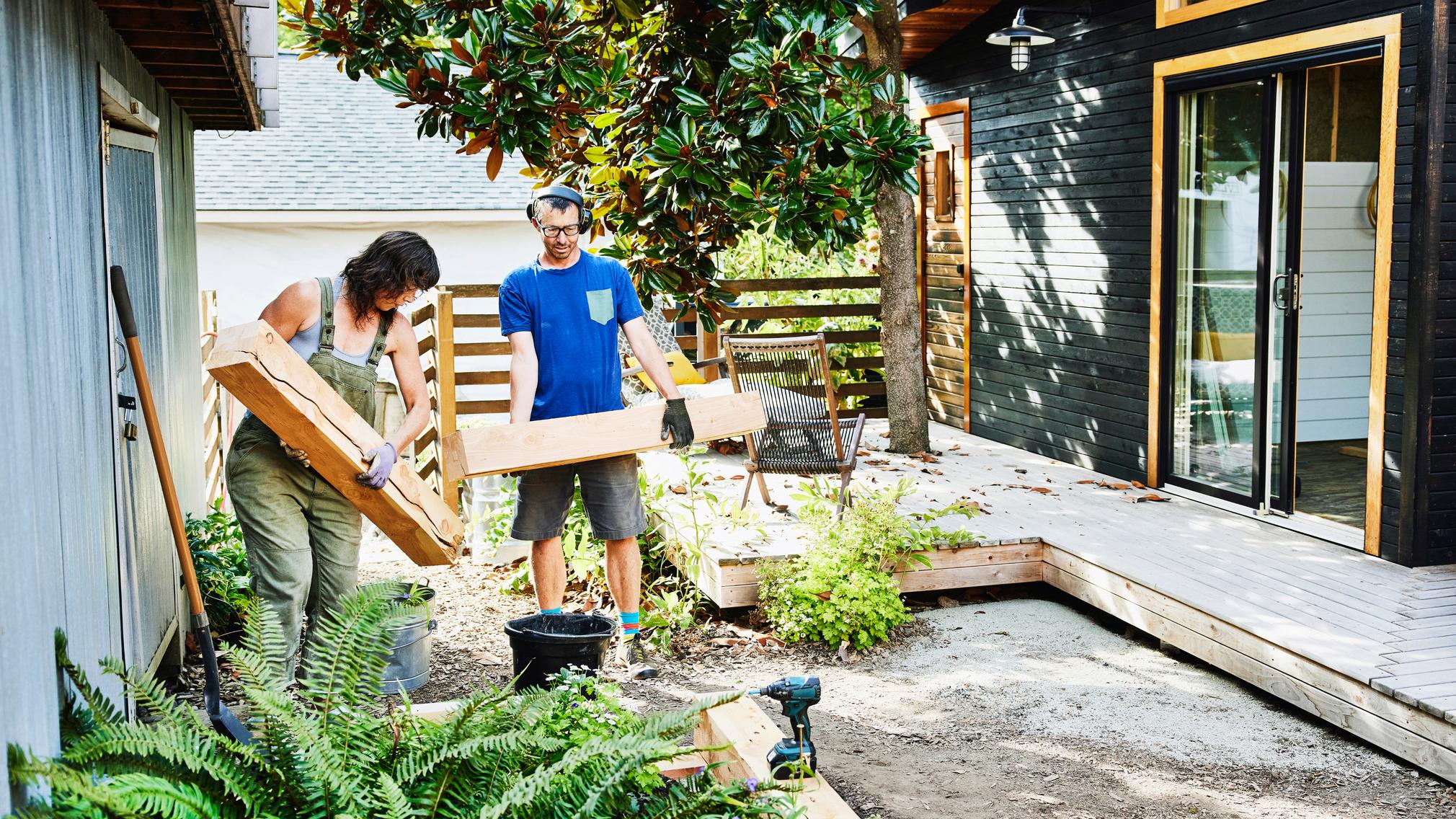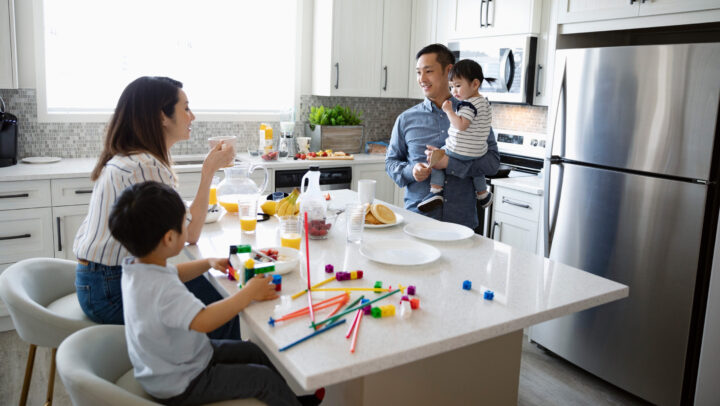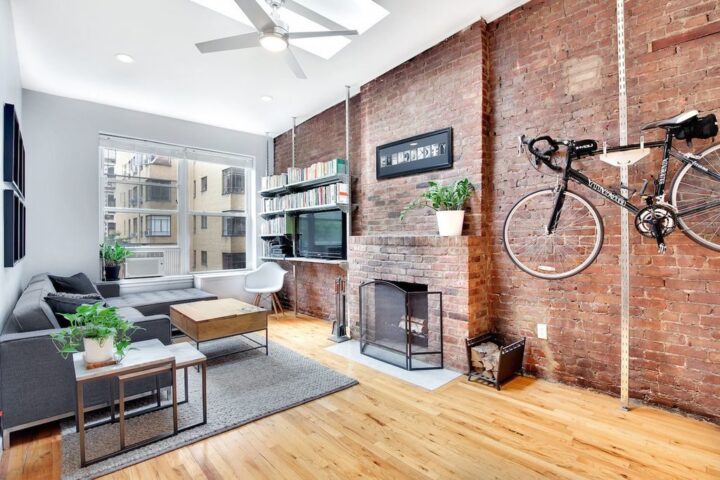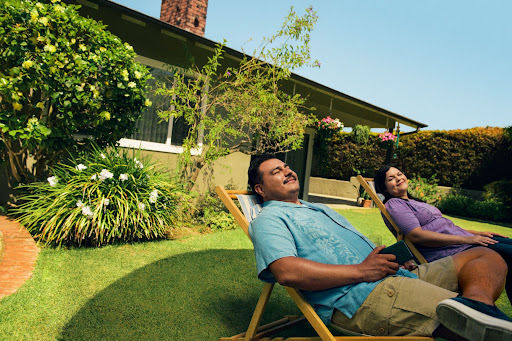Exterior Home Upgrades That Pay Off When You Sell
Make your home look its best (and maybe even net a higher sale price) with these improvements.


Written by May Ortega on May 21, 2025
In this article:
- Necessary exterior home upgrades
- Cosmetic exterior home upgrades
- The importance of outdoor space
- How important is curb appeal when selling a house?
- Does curb appeal add value to your home?
According to Remodeling magazine’s 2024 Cost vs. Value Report, eight of the 10 home improvements with the highest return on investment (ROI) are on the outside of the home. These projects recoup anywhere between 68% (for a new composite deck) to 194% (for a garage door replacement) of your initial investment once you sell your home.
Christie Cannon, a real estate agent with The Cannon Team at Keller Williams in Frisco, Texas, said your home’s appearance on the outside can be even more important than what it looks like on the inside.
“As a buyer is viewing photos, or walking up to the home for a showing, an opinion is being formed. This initial opinion will carry into the home,” Cannon said. “If a home looks well-maintained and updated from the outside, it builds trust that the interior is cared for too.”
We’ve put together a list of exterior home improvements — some necessary, others cosmetic — that could help you sell for more.
Necessary exterior home upgrades
You should address any functional exterior shortcomings before you break out your denim painting overalls. For example, a roof that’s missing shingles looks bad from the curb, and it's a red flag for buyers and their inspectors. A poorly maintained roof could signal that the home hasn’t been taken care of by its owners.
Roof repair: 57% ROI
According to a 2024 Zillow report, 15% of sellers repaired or replaced their roof before listing their home for sale. And 72% of buyers said it’s very important that a home has a water-tight roof. If your roof needs fixing, your options are: take care of it before listing; leave it as-is and lower your listing price; or be prepared to offer a buyer credit when you’re in negotiations.
If you need a full roof replacement, it can be expensive. A roofing replacement with asphalt shingles costs an average of $30,600, and it garners a 57% return on investment — or $17,400. That makes the unreturned cost for the seller $13,200. So weigh that against how a damaged roof could affect your final sale price.
Siding repair or replacement: 80% ROI
Another obvious defect buyers may notice is damaged or neglected siding. A vinyl siding replacement has an average national cost of $17,400, with an 80% ROI ($13,900). The unreturned cost for the seller is $3,500. If your home has a brick exterior or other material that doesn’t include siding, be sure there aren’t any major cracks, as that could be a sign of foundation damage.
Check for rotting wood
Wood siding and wood trimming break down over time due to weather, age, and even pests. This can be a cosmetic issue at first, but if it’s ignored for too long, rotting wood could cause leaking into the home or cracking walls, and it could cost you when you sell, too.
“Rotting wood is more than just cosmetic — it’s often a sign of deferred maintenance and can raise red flags during inspections,” Cannon said. “Fixing it before listing helps avoid price reductions during negotiations and presents a home that feels solid and move-in ready, which is exactly what today’s buyers are looking for.”
According to Thumbtack, homeowners report spending an average of $1,390 to install new wood siding.
New windows: 67% ROI
A vinyl window replacement costs $21,200 on average, with a 67% ROI ($14,200). A wood window replacement is a little more costly and has a lower average return, at $25,000, with a 63% ROI ($16,200). The unreturned costs for the seller are $7,000 or $8,800, respectively.
Expect buyers (or their inspectors) to pay close attention to the windows and doors, especially in older homes. If your home needs new windows and you decide to replace them before listing, it can be a huge selling point — especially if you opt for energy-efficient windows that will reduce heating and cooling costs for the home’s future owner.
Checking your windows
Inspect your windows in case they need to be repaired or replaced. You also can try these tips for improving the efficiency of your existing windows if they don’t need a full replacement:
- Check for drafts (this is an easy fix).
- Replace caulking or add weather stripping.
- Add storm shutters.
- Add solar film.
Note that awning or hopper windows (hinged at the top or bottom) and casement windows (hinged at the side) are less prone to leakage than sliding windows.
New front door: 188% ROI
A new front door can give your home's facade a whole new look, and it’s a more affordable improvement. A steel entry-door replacement costs an average of $2,300 and can get you an impressive 188% ROI ($4,400). The seller would make an extra $2,100. Before you replace your front door, though, see if a new coat of paint will do the trick; more on that later.
Add a grand entrance: 97% ROI
If you’re looking to replace your old front door, you could install a grand entrance while you’re at it. This involves expanding the space around your front door and installing a pair of sidelights (those thin windows that go on either side of the door), and adding a new front door to match. This could get you some major money back once you sell. While this project could cost you $11,300, you could recoup 97% of the project’s total cost ($11,000).
New garage door: 194% ROI
If standard repairs like a chain/track replacement or a fresh coat of paint won’t be enough to bring your garage door into excellent condition, you might need to install a new one. Luckily, a garage door replacement is the outdoor project with the highest ROI that’s tracked by Remodeling magazine, with a cost of $4,500 and an average ROI of 194% ($8,700). In this scenario, the seller would get $4,200 on top of what they invested.
Cosmetic exterior home upgrades
Cosmetic changes are things that don't necessarily need to be fixed, but they're worth doing if your goal is to sell your home for as much as you can. Remember — your home's exterior is the first thing buyers will see, and you only have one chance to make a good first impression. Cannon suggests taking on some optional additions to help you attract attention.
“Cosmetic upgrades are worth considering when a seller wants their home to stand out in a competitive market or in higher-end neighborhoods where buyers expect more,” she said. “These features can tap into emotional buying decisions and help a home feel more unique, which can translate to stronger offers.”
She adds that if you do choose to take on a cosmetic upgrade, make sure it has a good return on investment. Further down, we’ll talk more about how good curb appeal can get you more money when you sell.
Pressure wash
Pressure washing all the hard surfaces around your home's exterior is an easy way to give your home a nice polish, so it can look fresh and clean when it enters the market. Homes made of brick or stone could benefit from a pressure wash — just be careful when working near windows and other delicate surfaces. You can also target your sidewalks, curbs, pathways, and driveways to remove dirt, grime, and moss. Cannon said cleaning in this way can influence people beyond buyers.
“Not only are these things looked at from a buyer's perspective, but also when your home goes under contract — these details are viewed by appraisers as well,” she said.
Paint the exterior
Whether your home is desperately in need of a new coat of paint or you just want to freshen things up before listing, repainting your home's exterior is a fairly common task, with 19% of sellers completing the project before listing. Though, not all exterior materials will lend themselves to being painted, so take that into consideration.
Neutral and earthy paint colors appeal to the broadest group of buyers when it comes to the inside of your home, and the same goes for the outside. For example, Zillow found that recent and prospective buyers prefer olive green kitchens over all other colors; so much so, they’re willing to offer $1,590 more for homes with an olive green kitchen.
If you want a better idea of what colors may help you the most, you could ask your agent, or drive around the area and note the shades of the best-selling homes around you.
Paint the front door
As long as it closes and locks properly and doesn’t have any major damage, you can simply paint your front door instead of replacing it.
Homes with black front doors see offers that are $6,450 more than similar homes without black front doors, according to a 2022 Zillow study.
If you want to add a pop of color to your front facade, you may want to avoid pale pink. Zillow’s research found that both recent and prospective buyers would offer $6,500 less for a home with that front door color. Cement gray could result in $3,365 less as well.
Enhance the driveway
A driveway with some foliage planted along its borders could give this usually plain space some flair. If your driveway has cracks or other issues, it may be best to replace it. If you do go that route, you could add some dye to the concrete so your driveway has some color. You could also stamp a pattern or design into the concrete as it dries. Both of these additions could help your home stand out a bit and intrigue buyers. If your home doesn’t have a driveway, but you’ve been thinking of adding one, you have a few options for how to make it happen.
Do some landscaping
Another popular task on the pre-listing to-do list is landscaping the yard — a quarter of all sellers do some landscaping work before they sell. Consider trimming overgrown trees, branches, bushes, and ground cover, then plant colorful seasonal flowers, and add some fresh mulch. Homes with nice landscaping sell for 2% more, and about a day faster, according to Zillow’s research.
Add lighting
While not all buyers will see your home at night, it’s good to keep lighting in mind. Homes with outdoor lighting sold for 1.2% more than similar homes without. Adding short, solar-powered garden lights out front can make your home more inviting.
It could also help to update your outdoor sconces, especially if you're listing in winter, when the sun sets earlier and you may have buyers touring your home in the evening.
Accessorize the exterior
Curb appeal is huge, be it in person or online. Accessories and design touches make a home look polished, well-cared for, and updated. Consider these budget-friendly accessorizing tips that make a big impact:
- Add new house numbers in a classic bronze or black.
- Replace the mailbox with a new one that matches the home's style.
- Update the front door hardware — smart home locks are popular with buyers.
- Replace your old welcome mat with something clean and simple.
- Add some front porch furniture that matches the style of the home.
The importance of outdoor space
Although most pre-listing exterior home improvements focus on the front of the house, it can be helpful to spruce up the backyard or any other outdoor space you have, too. Zillow research found that homes equipped with an outdoor TV sold for 3% more. That’s the highest sale price premium of all 359 features Zillow analyzed across nearly 1 million home sales in 2023.
The biggest bang-for-your-buck backyard renovation, according to Remodeling magazine, is adding a wood deck. It offers the sixth-highest ROI of all the outdoor home improvements analyzed — for an average cost of $17,600, and a return of 83%. There are some other additions that could really boost your home’s popularity, too.
Install a saltwater pool
Installing any kind of pool can take a lot of time, work, and money. In some markets, especially those with warm climates, in-ground pools may add more value to the property than in colder climates, where a pool would get only a few months of use each year. Another factor is what type of pool you’re installing.
A recent Zillow® analysis found that homes with saltwater pools sell for 1.8% more than comparable homes without one — and they sell two days faster. Meanwhile, homes with a regular swimming pool sold for .3% less and took about a day longer to sell.
If you want to dip your toes into getting your own pool, consider things like the maintenance cost and all of the safety precautions you’d have to take when owning a pool.
Add an outdoor shower
Having a way to rinse off after a particularly dirty, sweaty, or sandy day before you even enter your home is an attractive prospect for buyers. Zillow research found that an outdoor shower was the top outdoor feature that can help a home sell for more — specifically, 2.3% more. Cannon said this can be particularly helpful depending on a few factors.
“I suggest focusing on upgrades that complement the lifestyle buyers are seeking, like an outdoor shower to complement an outdoor pool area, or in a beach or lake community,” she said.
How important is curb appeal when selling a house?
Curb appeal is important because it can have a positive impact on your home’s resale value.
Most sellers (72%) take on at least one home improvement project to prepare their home for sale, according to 2024 Zillow research. Landscaping ranks as the fourth most-common pre-listing upgrade. What does that mean for you as a seller? It means your competition is paying attention to curb appeal, so you should too. But Cannon said giving your home a bit of an update doesn’t have to break the bank.
“We always remind our sellers: you don’t have to do everything, but you should do what matters most in your price range and market,” Cannon said. “A good real estate agent will help you focus on where to spend money, as well as what not to spend your money on, to maximize your return.”
Although the majority of buyers (94%) use online resources to shop for homes, your curb appeal really does make the first impression, even digitally. Most agents use the exterior photo of your home as the first image in your online listing, and some local MLS systems require an exterior shot to come first.
Does curb appeal actually add value to your home?
Depending on the location, curb appeal can add value to your home. Your return on investment depends on the market itself, how much buyers value the improvements you’ve made, and the total spend on the upgrade. This is where a seller’s agent can be of help: they can give you insight on what improvements are popular in your area and give you info on comparable homes that recently sold in your market.
Between cleaning, staging, landscaping, painting, and other tasks, the typical seller spends roughly $5,380 to complete some of the most common pre-listing home improvements, according to a Zillow and Thumbtack analysis. Sellers spend money to complete these tasks in hopes of impressing buyers and receiving a strong offer as soon as possible.
And even if you’re not planning to sell just yet, every home update you make now could pay off in the long run.
Ready for a new address?
Get an instant cash offer or list with a local partner agent.
Explore selling optionsRelated Articles
Sell your home with a winning strategy
Here’s how to maximize your home sale with the right selling plan.

Build a smart selling plan
Talk to your agent about their marketing approach - especially online - to ensure you’re getting the best possible price for your home.



